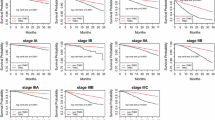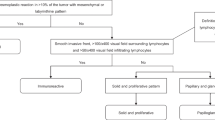Abstract
Background
The prognosis of muscle-invasive bladder cancer is poor. Molecular prognosticators have gained increasing attention for individualized therapeutic options because they can identify patients with different prognoses.
Methods
Tissue microarrays of formalin-fixed and paraffin-embedded tumor samples from 206 bladder cancer patients treated with cystectomy and chemotherapy were studied for SNAI1 protein expression by immunohistochemistry. SNAI1 expression was evaluated using an immunoreactive score (IRS). For statistical analysis, the patients were separated into two groups: those with tumor specimens negative for SNAI1 expression (IRS = 0), and the other positive for SNAI1 expression (IRS ≥1).
Results
Tumor samples from 42 patients showed negative SNAI1 expression, whereas the nuclei of tumor cells from 164 patients showed detectable nuclear staining of SNAI1. A Kaplan–Meier analysis of the bladder cancer patients with negative SNAI1 expression showed significantly reduced disease-specific survival (DSS) and progression-free survival (PFS) compared to the patients with positive expression (p = 0.010 and 0.013). A multivariate Cox regression analysis (adjusted for gender, age, tumor stage, tumor grade, lymph node metastasis, chemotherapy, and histologic subtype) again showed a significant correlation between patients lacking SNAI1 expression and DSS (p = 0.005; relative risk 2.31; 95 % confidence interval 1.28–4.17) or PFS (p = 0.004; relative risk 2.20; 95 % confidence interval 1.29–3.78) compared to patients with positive SNAI1 staining.
Conclusions
Loss of SNAI1 protein expression is an independent prognosticator for PFS and DSS in bladder cancer patients treated by radical cystectomy and adjuvant chemotherapy. Its prognostic value for neoadjuvant or adjuvant chemotherapy must be evaluated in further prospective randomized controlled trials.



Similar content being viewed by others
References
Ferlay J, Parkin DM, Steliarova-Foucher E. Estimates of cancer incidence and mortality in Europe in 2008. Eur J Cancer. 2010;46:765–81.
Stenzl A, Cowan NC, De Santis M, et al. Treatment of muscle-invasive and metastatic bladder cancer: update of the EAU guidelines. Eur Urol. 2011;59:1009–18.
Advanced Bladder Cancer (ABC) Meta-analysis Collaboration. Neoadjuvant chemotherapy in invasive bladder cancer: update of a systematic review and meta-analysis of individual patient data advanced bladder cancer (ABC) meta-analysis collaboration. Eur Urol. 2005;48:202–5.
Advanced Bladder Cancer (ABC) Meta-analysis Collaboration. Adjuvant chemotherapy in invasive bladder cancer: a systematic review and meta-analysis of individual patient data Advanced Bladder Cancer (ABC) Meta-analysis Collaboration. Eur Urol. 2005;48:189–99.
Scosyrev E, Messing EM, van Wijngaarden E, et al. Neoadjuvant gemcitabine and cisplatin chemotherapy for locally advanced urothelial cancer of the bladder. Cancer. 2012;118:72–81.
Frantzi M, Makridakis M, Vlahou A. Biomarkers for bladder cancer aggressiveness. Curr Opin Urol. 2012;22:390–6.
Smith BN, Odero-Marah VA. The role of Snail in prostate cancer. Cell Adh Migr. 2012;6:433–41.
Lin T, Ponn A, Hu X, Law BK, Lu J. Requirement of the histone demethylase LSD1 in SNAI1-mediated transcriptional repression during epithelial–mesenchymal transition. Oncogene. 2010;29:4896–904.
Waldmann J, Feldmann G, Slater EP, et al. Expression of the zinc-finger transcription factor Snail in adrenocortical carcinoma is associated with decreased survival. Br J Cancer. 2008;99:1900–7.
Yanagawa J, Walser TC, Zhu LX, et al. Snail promotes CXCR2 ligand-dependent tumor progression in non-small cell lung carcinoma. Clin Cancer Res. 2009;15:6820–9.
Kuo KT, Chou TY, Hsu HS, et al. Prognostic significance of NBS1 and Snail expression in esophageal squamous cell carcinoma. Ann Surg Oncol. 2012;19(Suppl 3):S549–57.
Tuhkanen H, Soini Y, Kosma VM, et al. Nuclear expression of Snail1 in borderline and malignant epithelial ovarian tumours is associated with tumour progression. BMC Cancer. 2009;9:289.
Luo WR, Li SY, Cai LM, Yao KT. High expression of nuclear Snail, but not cytoplasmic staining, predicts poor survival in nasopharyngeal carcinoma. Ann Surg Oncol. 2012;19:2971–9.
Jouppila-Mättö A, Närkiö-Mäkelä M, Soini Y, et al. Twist and Snai1 expression in pharyngeal squamous cell carcinoma stroma is related to cancer progression. BMC Cancer. 2011;11:350.
Mikami S, Katsube K, Oya M, et al. Expression of Snail and Slug in renal cell carcinoma: E-cadherin repressor Snail is associated with cancer invasion and prognosis. Lab Invest. 2011;91:1443–58.
Heebøll S, Borre M, Ottosen PD, Dyrskjøt L, Orntoft TF, Tørring N. Snail1 is over-expressed in prostate cancer. APMIS. 2009;117:196–204.
Elloul S, Elstrand MB, Nesland JM, et al. Snail, Slug, and Smad-interacting protein 1 as novel parameters of disease aggressiveness in metastatic ovarian and breast carcinoma. Cancer. 2005;103:1631–43.
Hsu DS, Lan HY, Huang CH, et al. Regulation of excision repair cross-complementation group 1 by Snail contributes to cisplatin resistance in head and neck cancer. Clin Cancer Res. 2010;16:4561–71.
Kosaka T, Kikuchi E, Mikami S, et al. Expression of snail in upper urinary tract urothelial carcinoma: prognostic significance and implications for tumor invasion. Clin Cancer Res. 2010;16:5814–23.
Bruyere F, Namdarian B, Corcoran NM, et al. Snail expression is an independent predictor of tumor recurrence in superficial bladder cancers. Urol Oncol. 2010;28:591–6.
Yu Q, Zhang K, Wang X, Liu X, Zhang Z. Expression of transcription factors Snail, Slug, and Twist in human bladder carcinoma. J Exp Clin Cancer Res. 2010;29:119.
Lehmann J, Retz M, Wiemers C, et al. Adjuvant cisplatin plus methotrexate versus methotrexate, vinblastine, epirubicin, and cisplatin in locally advanced bladder cancer: results of a randomized, multicenter, phase III trial (AUO-AB 05/95). J Clin Oncol. 2005;23:4963–74.
Peinado H, Olmeda D, Cano A. Snail, Zeb and bHLH factors in tumour progression: an alliance against the epithelial phenotype? Nat Rev Cancer. 2007;7:415–28.
Schulz WA. Understanding urothelial carcinoma through cancer pathways. Int J Cancer. 2006;119:1513–8.
van Meeteren LA, Thorikay M, Bergqvist S, et al. Anti-human activin receptor-like kinase 1 (ALK1) antibody attenuates bone morphogenetic protein 9 (BMP9)-induced ALK1 signaling and interferes with endothelial cell sprouting. J Biol Chem. 2012;287:18551–61.
van Meeteren LA, ten Dijke P. Regulation of endothelial cell plasticity by TGF-β. Cell Tissue Res. 2012;347:177–86.
Chiang C, Ayyanathan K. Snail/Gfi-1 (SNAG) family zinc finger proteins in transcription regulation, chromatin dynamics, cell signaling, development, and disease. Cytokine Growth Factor Rev. 2013;24(2):123–31.
Acknowledgment
We thank American Journal Experts for language editing.
Conflict of interest
The authors declare no conflict of interest.
Author information
Authors and Affiliations
Corresponding author
Rights and permissions
About this article
Cite this article
Keck, B., Wach, S., Goebell, P.J. et al. SNAI1 Protein Expression is an Independent Negative Prognosticator in Muscle-Invasive Bladder Cancer. Ann Surg Oncol 20, 3669–3674 (2013). https://doi.org/10.1245/s10434-013-3075-6
Received:
Published:
Issue Date:
DOI: https://doi.org/10.1245/s10434-013-3075-6




